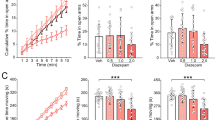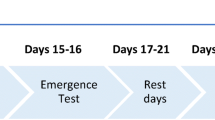Abstract
Rationale
Oxytocin (OT) acts as a neuromodulator/neurotransmitter within the central nervous system (CNS) and regulates a diverse range of CNS functions. Notably, evidence from studies in females has revealed an important role for OT in regulating anxiety behavior.
Objectives
The objective of this study was to examine the effects of OT on both behavioral and autonomic parameters of the anxiety response in male mice using three pharmacologically validated preclinical models of anxiety: the four-plate test (FPT), elevated zero maze (EZM), and stress-induced hyperthermia (SIH).
Results
In the FPT, both peripherally (3–30 mg/kg i.p.) and centrally (1–10 μg i.c.v.) administered OT produced dose-dependent increases in punished crossings, indicating an anxiolytic-like effect. The effects of centrally administered OT in the FPT were blocked with peripheral administration of a brain-penetrant OT receptor (OTR) antagonist WAY-162720 (30 mg/kg i.p.), and the effects of peripherally administered OT were blocked with central administration of a non-penetrant OTR antagonist L-371,257, suggesting OT acts centrally. In the EZM, centrally administered OT (0.1–1.0 μg, i.c.v.) produced significant increases in the percentage time spent in the open quadrants of the maze, comparable to alprazolam (0.5–1.0 μg, i.c.v.). In SIH, OT (1–10 mg/kg i.p.) dose-dependently attenuated stress-induced increases in core body temperature, comparable to the reference anxiolytic chlordiazepoxide (CDP) (10 mg/kg i.p.).
Conclusions
These results provide specific behavioral and autonomic evidence of anxiolytic-like effects for oxytocin in males and, together with previously reported observations in females, suggest the potential utility of OTR agonism as a therapeutically relevant mechanism of action for novel anxiolytics in both sexes.




Similar content being viewed by others
References
Altemus M (1995) Neuropeptides in anxiety disorders. Effects of lactation. Ann N Y Acad Sci 771:697–707
Amico JA, Mantella RC, Vollmer RR, Li X (2004a) Anxiety and stress responses in female oxytocin deficient mice. J Neuroendocrinol 16:319–324
Amico JA, Vollmer RR, Karam JR, Lee PR, Li X, Koenig JI, McCarthy MM (2004b) Centrally administered oxytocin elicits exaggerated grooming in oxytocin null mice. Pharmacol Biochem Behav 78:333–339
Argiolas A, Gessa GL (1991) Central functions of oxytocin. Neurosci Biobehav Rev 15:217–231
Aron C, Simon P, Larousse C, Boissier JR (1971) Evaluation of a rapid technique for detecting minor tranquilizers. Neuropharmacology 10:459–469
Bale TL, Davis AM, Auger AP, Dorsa DM, McCarthy MM (2001) CNS region-specific oxytocin receptor expression: importance in regulation of anxiety and sex behavior. J Neurosci 21:2546–2552
Bielsky IF, Young LJ (2004) Oxytocin, vasopressin, and social recognition in mammals. Peptides 25:1565–1574
Borsini F, Lecci A, Volterra G, Meli A (1989) A model to measure anticipatory anxiety in mice? Psychopharmacology (Berl) 98:207–211
Bourin M, Hascoet M, Mansouri B, Colombel MC, Bradwejn J (1992) Comparison of behavioral effects after single and repeated administrations of four benzodiazepines in three mice behavioral models. J Psychiatry Neurosci 17:72–77
DSM-IV-TR (2000) Diagnostic and statistical manual of mental disorders (DSM-IV-TR), 4th edn (text revision). American Psychiatric Association
Engelmann M, Ebner K, Wotjak CT, Landgraf R (1998) Endogenous oxytocin is involved in short-term olfactory memory in female rats. Behav Brain Res 90:89–94
Ermisch A, Barth T, Ruhle HJ, Skopkova J, Hrbas P, Landgraf R (1985) On the blood–brain barrier to peptides: accumulation of labelled vasopressin, DesGlyNH2-vasopressin and oxytocin by brain regions. Endocrinol Exp 19:29–37
Feifel D, Reza T (1999) Oxytocin modulates psychotomimetic-induced deficits in sensorimotor gating. Psychopharmacology (Berl) 141:93–98
Hascoet M, Bourin M, Colombel MC, Fiocco AJ, Baker GB (2000) Anxiolytic-like effects of antidepressants after acute administration in a four-plate test in mice. Pharmacol Biochem Behav 65:339–344
Holst S, Uvnas-Moberg K, Petersson M (2002) Postnatal oxytocin treatment and postnatal stroking of rats reduce blood pressure in adulthood. Auton Neurosci 99:85–90
Huber D, Veinante P, Stoop R (2005) Vasopressin and oxytocin excite distinct neuronal populations in the central amygdala. Science 308:245–248
Insel TR, Shapiro LE (1992) Oxytocin receptor distribution reflects social organization in monogamous and polygamous voles. Proc Natl Acad Sci U S A 89:5981–5985
Jones PM, Robinson IC (1982) Differential clearance of neurophysin and neurohypophysial peptides from the cerebrospinal fluid in conscious guinea pigs. Neuroendocrinology 34:297–302
Kash SF, Tecott LH, Hodge C, Baekkeskov S (1999) Increased anxiety and altered responses to anxiolytics in mice deficient in the 65-kDa isoform of glutamic acid decarboxylase. Proc Natl Acad Sci U S A 96:1698–1703
Kruse J (1986) Oxytocin: pharmacology and clinical application. J Fam Pract 23:473–479
Lee C, Rodgers RJ (1990) Antinociceptive effects of elevated plus-maze exposure: influence of opiate receptor manipulations. Psychopharmacology (Berl) 102:507–513
Mantella RC, Vollmer RR, Li X, Amico JA (2003) Female oxytocin-deficient mice display enhanced anxiety-related behavior. Endocrinology 144:2291–2296
McCarthy MM (1990) Oxytocin inhibits infanticide in female house mice (Mus domesticus). Horm Behav 24:365–375
McCarthy MM, Kow LM, Pfaff DW (1992) Speculations concerning the physiological significance of central oxytocin in maternal behavior. Ann N Y Acad Sci 652:70–82
McCarthy MM, McDonald CH, Brooks PJ, Goldman D (1996) An anxiolytic action of oxytocin is enhanced by estrogen in the mouse. Physiol Behav 60:1209–1215
Morris M, Callahan MF, Li P, Lucion AB (1995) Central oxytocin mediates stress-induced tachycardia. J Neuroendocrinol 7:455–459
Neumann ID (2002) Involvement of the brain oxytocin system in stress coping: interactions with the hypothalamo–pituitary–adrenal axis. Prog Brain Res 139:147–162
Neumann ID, Torner L, Wigger A (2000) Brain oxytocin: differential inhibition of neuroendocrine stress responses and anxiety-related behaviour in virgin, pregnant and lactating rats. Neuroscience 95:567–575
Numan M, Insel TR (2003) The neurobiology of parental behavior. Springer, Berlin Heidelberg New York
Oka T, Oka K, Hori T (2001) Mechanisms and mediators of psychological stress-induced rise in core temperature. Psychosom Med 63:476–486
Olivier B, Zethof T, Pattij T, van Boogaert M, van Oorschot R, Leahy C, Oosting R, Bouwknecht A, Veening J, van der Gugten J, Groenink L (2003) Stress-induced hyperthermia and anxiety: pharmacological validation. Eur J Pharmacol 463:117–132
Pellow S, Chopin P, File SE, Briley M (1985) Validation of open:closed arm entries in an elevated plus-maze as a measure of anxiety in the rat. J Neurosci Methods 14:149–167
Ring RH (2005) The central vasopressinergic and oxytocinergic systems as targets for psychiatric drug development neurohypophyseal hormones: from genomics and physiology to disease. American Physiological Society, Steamboat Springs, Colorado, p 162
Robinson DA, Wei F, Wang GD, Li P, Kim SJ, Vogt SK, Muglia LJ, Zhuo M (2002) Oxytocin mediates stress-induced analgesia in adult mice. J Physiol 540:593–606
Rodgers RJ, Lee C, Shepherd JK (1992) Effects of diazepam on behavioural and antinociceptive responses to the elevated plus-maze in male mice depend upon treatment regimen and prior maze experience. Psychopharmacology (Berl) 106:102–110
Shepherd JK, Grewal SS, Fletcher A, Bill DJ, Dourish CT (1994) Behavioural and pharmacological characterisation of the elevated “zero-maze” as an animal model of anxiety. Psychopharmacology (Berl) 116:56–64
Tsatsaris V, Carbonne B, Cabrol D (2004) Atosiban for preterm labour. Drugs 64:375–382
Uvnäs-Moberg K, Widstrom A-M, Nissen E, Bjorvell H (1990) Personality traits in women 4 days postpartum and their correlation with plasma levels of oxytocin and prolactin. J Psychosom Obstet Gynaecol 11:261–273
Uvnäs-Moberg K, Alster P, Hillegaart V, Ahlenius S (1992) Oxytocin reduces exploratory motor behaviour and shifts the activity towards the centre of the arena in male rats. Acta Physiol Scand 145:429–430
Uvnäs-Moberg K, Ahlenius S. Hillegaart V, Alster P (1994) High doses of oxytocin cause sedation and low doses cause an anxiolytic-like effect in male rats. Pharmacol Biochem Behav 49:101–106
Williams PD, Clineschmidt BV, Erb JM, Freidinger RM, Guidotti MT, Lis EV, Pawluczyk JM, Pettibone DJ, Reiss DR, Veber DF et al (1995) 1-(1-[4-[(N-Acetyl-4-piperidinyl)oxy]-2-methoxybenzoyl]piperidin-4- yl)-4H-3,1-benzoxazin-2(1H)-one (L-371,257): a new, orally bioavailable, non-peptide oxytocin antagonist. J Med Chem 38:4634–4636
Windle RJ, Shanks N, Lightman SL, Ingram CD (1997) Central oxytocin administration reduces stress-induced corticosterone release and anxiety behavior in rats. Endocrinology 138:2829–2834
Windle RJ, Kershaw YM, Shanks N, Wood SA, Lightman SL, Ingram CD (2004) Oxytocin attenuates stress-induced c-fos mRNA expression in specific forebrain regions associated with modulation of hypothalamo–pituitary–adrenal activity. J Neurosci 24:2974–2982
Winslow JT, Hearn EF, Ferguson J, Young LJ, Matzuk MM, Insel TR (2000) Infant vocalization, adult aggression, and fear behavior of an oxytocin null mutant mouse. Horm Behav 37:145–155
Zethof TJ, Van der Heyden JA, Tolboom JT, Olivier B (1995) Stress-induced hyperthermia as a putative anxiety model. Eur J Pharmacol 294:125–135
Author information
Authors and Affiliations
Corresponding author
Rights and permissions
About this article
Cite this article
Ring, R.H., Malberg, J.E., Potestio, L. et al. Anxiolytic-like activity of oxytocin in male mice: behavioral and autonomic evidence, therapeutic implications. Psychopharmacology 185, 218–225 (2006). https://doi.org/10.1007/s00213-005-0293-z
Received:
Accepted:
Published:
Issue Date:
DOI: https://doi.org/10.1007/s00213-005-0293-z




